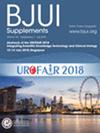根据pre-RT国际前列腺症状评分,前列腺癌根治性放疗(RT)后尿路事件。
IF 4.4
2区 医学
Q1 UROLOGY & NEPHROLOGY
引用次数: 0
摘要
目的:根据前列腺体积、放疗类型和新辅助雄激素剥夺治疗(ADT)的使用情况,描述根治性放疗(RT)后泌尿道事件的风险,因为接受根治性放疗的前列腺癌患者有泌尿道事件的风险。纳入2018年至2023年期间在瑞典国家前列腺癌登记处接受RT治疗并在诊断时登记IPSS的患者和方法人员。IPSS分为:低,0-7;温和,8-19;严重的,20-35分。尿路事件定义为治疗后的下尿路症状、感染和泌尿外科手术,并根据《国际疾病和相关健康问题分类》第十版代码和《患者登记册》中的程序进行评估。根据IPSS、前列腺体积、RT类型和新辅助ADT的使用,计算RT后3年尿路事件累积发生率的竞争风险。结果纳入的4436名男性中,43%为轻度,44%为中度,13%为重度放疗前IPSS。3年时,轻度IPSS患者的泌尿系统事件发生率为19%,中度IPSS患者为28%,重度IPSS患者为39%。IPSS与尿路事件之间的关联在基于前列腺体积、RT类型和新辅助ADT使用的亚组中被观察到。IPSS每增加5个单位,3年内发生尿路事件的风险就会增加20%。结论放疗前较高的IPSS是放疗后尿路事件风险增加的一个指标——无论是在总体上还是在前列腺体积、放疗类型和新辅助ADT使用的亚组内。本文章由计算机程序翻译,如有差异,请以英文原文为准。
Urinary tract events after radical radiotherapy (RT) for prostate cancer according to pre-RT International Prostate Symptom Score.
OBJECTIVE
To describe the risk of urinary tract events after radical radiotherapy (RT) according to pre-RT (IPSS) overall and within subgroups of prostate volume, type of RT, and use of neoadjuvant androgen-deprivation therapy (ADT), as men who undergo RT for prostate cancer have a risk of urinary tract events.
PATIENTS AND METHODS
Men in the National Prostate Cancer Register of Sweden who underwent RT between 2018 and 2023 for whom IPSS was registered at diagnosis were included. The IPSS was stratified as: low, 0-7; moderate, 8-19; and severe, 20-35 points. Urinary tract events were defined as lower urinary tract symptoms, infections, and urological procedures after treatment and assessed based on International Classification of Diseases and Related Health Problems, 10th Revision codes and procedures in The Patient Register. Competing risk of cumulative incidence proportion of urinary tract events at 3 year after RT was computed according to the IPSS, prostate volume, type of RT, and use of neoadjuvant ADT.
RESULTS
Of the 4436 men included, 43% had mild, 44% moderate, and 13% severe pre-RT IPSS. Incidence of urinary tract events after RT was 19% at 3 years for men with mild IPSS, 28% for moderate IPSS, and 39% for severe IPSS. The association between IPSS and urinary tract events was observed within subgroups based on prostate volume, type of RT, and use of neoadjuvant ADT. A 5-unit increase in IPSS carried a 20% increased risk of having a urinary tract event within 3 years.
CONCLUSION
A higher pre-RT IPSS is an indicator of increased risk of urinary tract events after RT - both overall and within subgroups of prostate volume, type of RT, and use of neoadjuvant ADT.
求助全文
通过发布文献求助,成功后即可免费获取论文全文。
去求助
来源期刊

BJU International
医学-泌尿学与肾脏学
CiteScore
9.10
自引率
4.40%
发文量
262
审稿时长
1 months
期刊介绍:
BJUI is one of the most highly respected medical journals in the world, with a truly international range of published papers and appeal. Every issue gives invaluable practical information in the form of original articles, reviews, comments, surgical education articles, and translational science articles in the field of urology. BJUI employs topical sections, and is in full colour, making it easier to browse or search for something specific.
 求助内容:
求助内容: 应助结果提醒方式:
应助结果提醒方式:


